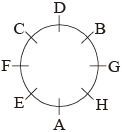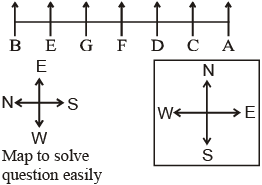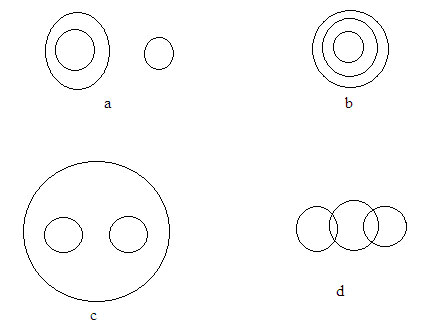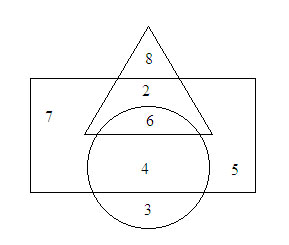Seating Arrangement - Short-cut Tricks And Examples
In such problems a group of people, objects, etc, may have to be is arranged in a row or in a circle or any other way. Let us see the example given below:
Example: Just read the following informations carefully to answer the questions given below it:
| Five friends P, Q, R, S, and T are sitting on a bench: (i) P is sitting next to Q. (ii) R is sitting next to S. (iii) S is not sitting with T. (iv) T is on the last end of the bench. (v) R is on the 2nd position from the right. (vi) P is on the right of Q and T. (vii) P and R are sitting together. |
1. Where is P sitting?
- Between S and R
- Between S and R
- Between T and S
- Between S and T
- Between Q and R
2. Who is sitting in the centre?
- P
- Q
- R
- S
- T
3. R is sitting between……………
- Q and S
- P and T
- S and T
- P and S
- P and Q
4. What is the position of S?
- Extreme left
- Extreme right
- Third from left
- Second from left
- None of these
5. What is the position of Q?
- 2nd from right
- Centre
- Extreme left
- 2nd from left
- None of these
Now, point to be noted that in arrangement problems the actual information can be classified into 2 categories:
- Definite information: A definite information is one when the place of object/man is definitely mentioned.
- Comparative information: In such information the place of object/man is not mentioned definitely but only a comparative position is given. In other words the positions of objects/men are given in comparison to another objects/men.
Now, to solve the problem go as per the following steps:
- Step I: Sketch a diagram of empty places
- Step II: Fill up as many empty places as possible using all the definite informations.
- Step III: With the help of comparative information consider all possibilities and select the possibilities which does not violate any condition.
Now, we can solve the given example:
Here 4th and 5th sentences constitute definite information:
Comparative informations are: 1st, 2nd, 6th and 7th sentences while 3rd is a negative information.
Now, start with definite information, sketch the following arrangement:
T __ __ R __
Now, this is the time to look for the comparative informations that tell about T and R. Such informations are 2nd, 6th and 7th sentences. Take the 7th and the 1st sentence. If P and R are together and also Q and P are together, then P must be between Q and R. Now the arrangement take the form as:
T Q P R ____
By the virtue of the 2nd sentence:
T Q P R S
Now, look at the given questions and check that you get the following answer:
| 1. (5) | 2. (1) | 3. (4) | 4. (2) | 5. (4) |
Solved Examples
Directions: Study the following information carefully and answer the question given below:
| A, B, C, D, E, F, G and H are sitting around a circle facing at the centre. D is second to the left of F and third to the right of H. A is second to the right of F and an immediate neighbour of H. C is second to the right of B and F is third to the right of B. G is not an immediate neighbour of F. |
Question 1. How many of them, are there between H and C?
- Two
- Three
- Two or Three
- Data inadequate
- None of these
Question 2. Who is to the immediate left of A?
- H
- E
- G
- Data inadequate
- None of these
Question 3. In which of the following pairs is the first person sitting to the immediate left of the second person?
- CD
- BG
- HA
- FC
- None of these
Question 4. Who is fourth to the right of B ?
- E
- C
- A
- Data inadequate
- None of these
Question 5. What is E’s position with respect to G?
- Second to the right
- Third to the left
- Third to the right
- Second to the left
- None of these
Solution (Q. 1-5): Seating arrangement is as follows:

| Answers | 1. (2) | 2. (2) | 3. (4) | 4. (1) | 5. (2) |
Directions: On the basis of the information given below, select the correct alternative as answer for the questions which follow the information.
(i) A, B, C, D, E, F and G are sitting on a wall facing east.
(ii) C is just right of D.
(iii) B is on end point and E is his neighbour.
(iv) G is sitting between E and F.
(v) D is third from south end. |
Question 6.Which of the following is a pair of parsons who is on end points?
- AE
- AB
- FB
- CB
Question 7. Which of the following information is not necessary to determine the position of A?
- i
- ii
- iii
- All informations are necessary
Question 8. D is sitting between which of the following pairs?
- CE
- AC
- CF
- AF
Question 9. C want his seat as third from north, he will have to exchange the seat from which person?
- G
- F
- E
- Cannot be determined
Question 10. Who is seated right side of E ?
- F
- D
- C
- G
Solutions (6-10): Given information diagrammatically can be shown as follows:

6. (2): A and B is a pair of persons who is at the end points.
7. (4): All informations are necessary
8. (3): D is sitted between C and F.
9. (4): He will have to exchange his seat from G.
10. (5): G is seated right side of E.



